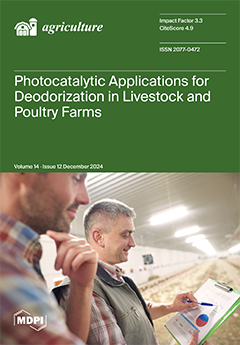The yellow spot disease of
Pleurotus ostreatus, caused by the bacterium
Pseudomonas tolaasii, poses a threat to both the yield and quality of oyster mushrooms due to the limited availability of effective bactericides and the insufficient comprehensive safety assessments for the
[...] Read more.
The yellow spot disease of
Pleurotus ostreatus, caused by the bacterium
Pseudomonas tolaasii, poses a threat to both the yield and quality of oyster mushrooms due to the limited availability of effective bactericides and the insufficient comprehensive safety assessments for the chemicals applied in the field. In this study, we performed greenhouse toxicity tests to identify highly effective bactericides against
P. tolaasii, while simultaneously assessing their safety for
P. ostreatus. Subsequently, we verified the field efficacy of the selected bactericide and its impact on mushroom yield through field experiments. Additionally, we established detection methods for the selected highly effective and safe bactericides in
P. ostreatus and measured their residue levels during the evaluation. Our findings indicated that kasugamycin and seboctylamine acetate displayed potent inhibitory effects against
P. tolaasii. The field application results showed that 1.8% seboctylamine acetate AS with concentrations of 3 mg/L exhibited good disease control, achieving 83.00%, which is comparable to the efficacy of the registered kasugamycin. Furthermore, the application of seboctylamine acetate did not adversely affect the yield of
P. ostreatus, and the detected chemical residues were below the maximum residue limit. Seboctylamine acetate is anticipated to serve as a viable substitute for the currently registered fungicides, holding the promise of offering comparable or superior performance while potentially addressing concerns related to environmental impact and sustainability.
Full article





